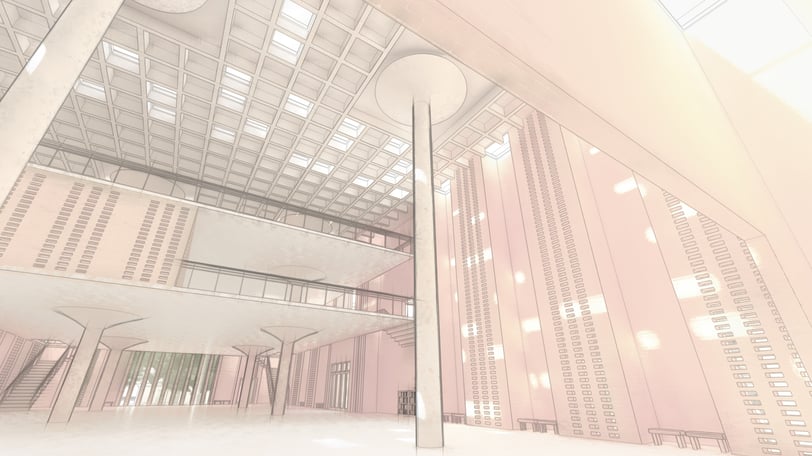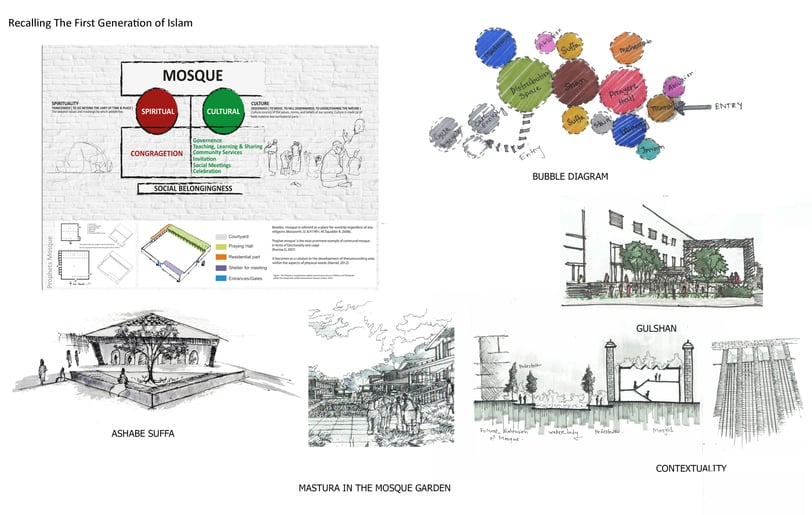Acclimatization Of First Generation Islamic Architecture: A Direction Towards Contemporary Mosque
The major goal of this blog is to examine First Generation Islamic Architecture, or how Islamic architectural components produced during the Prophet's time from Khulafay Rashedin, can be blended with Bangladeshi contextual mosques to create a new modern mosque architectural style.
HERITAGETHEORETICAL ARCHITECTURECULTURE
Muhammad Golam Sami
9/30/20194 min read


Image: KUET Mosque Design Project, Muhammad Golam Sami' 2019
Islamic architecture is one of the most extensively researched topics in architectural history. Because there are around one and a half billion Muslims worldwide, religion and the Islamic way of life play a significant role in their lives. The mosque, an architectural location where people exercise Islamic religious qualities, is one of the most essential parts of this Islamic practice. It is not only designed for prayer but it is also utilized to improve the overall living system. Mosques have been constructed throughout Islam's early history, and as the calendar and Islam moved around the world, the architectural aspects of these mosques began to adapt to varied local and historical styles. For example, the Mughals, Tughlaqs, Khiljis, and Lodis brought Islam to the Indian subcontinent. When they arrived, they immediately began establishing their own architectural style, Islamic architecture. Not only that, but it also incorporates local architectural styles. The mosques built in China are the best examples of contextual adaptation. Mosques were the most notable forms of architecture as Islam evolved in China, particularly the adaption of Hui-style architecture. Because Chinese mosques feature essential Islamic principles yet look drastically different from other mosques throughout the world. Mosque design has seen major transformations in modern practice. Although the crucial ideas remain the same, the historical aspect and decorative aspects are minimized, with contextual features, vernacularity, modernist ideals, and so on taking their place. Chinese Islamic architecture can be considered a pioneer in terms of contextual architectural practice. Still, the contextual features that were not implemented in Islamic architecture in the subcontinent during the Bengal Sultanate or the Mughal period cannot be considered comprehensive. The use of sandstone conveys the identity of the western half of the subcontinent, much as the use of brick or terracotta carries the character of Bengal. The usage of shattered temple components in mosques also contributes to regional architecture.
My major goal in this blog is to examine First Generation Islamic Architecture, or how Islamic architectural components produced during the Prophet's time from Khulafay Rashedin, can be blended with Bangladeshi contextual mosques to create a new modern mosque architectural style.
Some distinctive elements of the mosque were recognized when the Prophet erected it during the initial period of Islam. It has a Qibla Wall, a covered prayer area, a back-shaded area, an open courtyard, a residential section, and a meeting space. It is apparent that the initial goal of Masjid Toiri was not simply for prayer, but it has evolved into a life regulator. It is known as the communal mosque, and it all began with the Prophet's hand. So, according to Prophet Muhammad (pbuh), collaborative growth, sociopolitical development, and sociocultural development must start with the mosque. The use of mosques as social catalysts can be incorporated into contemporary Islamic architecture built in mosques. This social plan later took expression in several specific elements under the reign of Kholafaye Rashedin, the details of which are described below:
1. Ashab e Suffa: Ashab e Suffa means Balcony Dwellers. Sufism occurred in Islam's early days, with practitioners sitting on mosque verandahs. The balcony is significant in conveying spirituality.
2. Mastura: A Mastura is a gathering to spread the general Islamic religion. This shared meeting location provides a divine vibe while enhancing the mosque's surroundings. The concept of Gulshan supports this.
3. Gulshan: The mosque garden, historically a very ancient notion, landscape design in mosque surrounds, and its usefulness in promoting the social development of mosques are prominent concepts in Islam that reflect or are spiritually suggestive of Jannatul Firdaus or Heaven.
4. Contextuality: When discussing contextuality in Bangladesh, using brick, terracotta, perforation, and other materials is significant. Play-off lights, daylight accessibility, cross ventilation, and water bodies also create comfort. Green courts, courtyards, and gardens are equally noteworthy.
5. Spirituality: Spirituality is an essentially ethereal idea. Mental fills and sublimation are completely necessary. The means for expressing spiritual stuff through architectural and physical aspects is now far more diverse. Because it includes not just a philosophy but also the dimensions of how a person will feel psychologically and physically in a location. Waterbodies play an essential role in our contextual spirituality. On the other side, the play and visually appealing penetration of daylight blossoms into a form of illumination, representing society, culture, and everything it represents. In the Bengali setting, these two things might serve as spiritual guidance.
Finally, we can create a sustainable mosque that will thrive as an essential part of a community by improving spatial connectedness for communal development, incorporating vernacular elements, and adopting early and first-generation Islamic architectural ideology.


Figure 1: Conceptual Diagram
Meet The Author
Related ARTICLES
Related PROJECTS
DESIGN OF KUET MOSQUE: AN ABODE OF SPIRITUALITY
In this project, I studied Mayor Mohammad Hanif Mosque in Dhaka, designed by renowned Bangladeshi Architect Rafiq Azam, and introduced a design improvement challenge based on its core design concept.
Image: Architecture School Project - Perspective
Location: KUET, Khulna; Year: 2019







